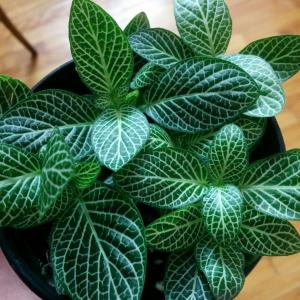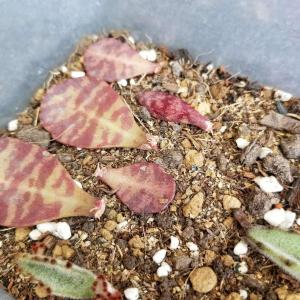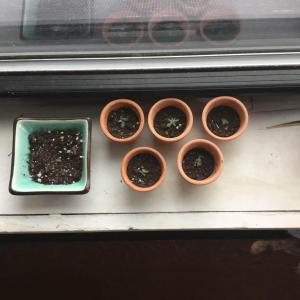Lucky Coyote
2017年12月29日

Just started germination for my herb garden, there's Marjoram, Broad leaf Sage, and Rosemary. I'll be starting some catnip as well ❤️ Any growing pointers would be amazing help
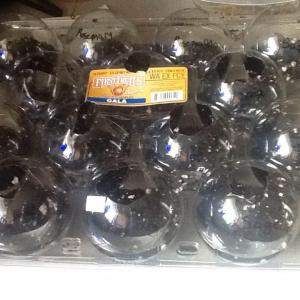

1
0
文章
Miss Chen
2017年12月23日

Description: This perennial wildflower is 1½–3' tall, consisting of some basal leaves and a flowering stem with alternate leaves. The basal leaves are up to 4" long and 4" across; each basal leaf is palmately divided into 3-5 segments, and each of these segments are subdivided into linear lobes about 3-4 mm. across. The slender petioles of the basal leaves are up to 4" long. The alternate leaves are similar in appearance to the basal leaves, except they become smaller while ascending the stem and their petioles are shorter. The basal leaves, alternate leaves, and the petioles are finely pubescent and whitish green to green. The central stem is terete, short-pubescent, and whitish green; it is unbranched or sparingly branched where the floral racemes occur. The central stem terminates in an elongated raceme of flowers about ½–1' long; sometimes there are 1 or 2 lateral racemes that are shorter. Individual flowers are about 1" long and 1" across; depending on the local ecotype, they vary in color from light blue to deep blue-violet.
Each flower consists of 5 sepals, 4 petals, 3 pistils, and numerous stamens. The petal-like sepals spread outward and they have rounded tips; the base of the uppermost sepal forms the ascending nectar spur, which curves upward. Near the tip of each sepal, there is often a patch of green. The small upper petals form a short hood over the throat of the flower and their bases extend into the nectar spur; they are often more white or light-colored than the lower petals or sepals. The lower petals are cleft and covered with fine woolly hairs; sometimes they are slightly purple. The pedicel of each flower is about 1" long and ascending; it has a pair of tiny linear bracts toward the middle. Near the base of each pedicel, there is a single linear bract that is larger in size and ascending. The blooming period occurs from late spring to early summer and lasts about 3-4 weeks. Each flower lasts about 1 week; several flowers are often in bloom at the same time. Each flower is replaced by a cluster of 3 seedpods (technically, follicles) that are joined together at the base. The individual seedpods are about ½–¾" long, angular in shape, and beaked; they are held erect. Each seedpod splits open along the inner side to release its seeds. The angular seeds are short-oblongoid with appressed scales; they are slightly winged along their margins. The root system is coarsely fibrous. Reproduction is by seed.

Cultivation: The preference is full sun, rather dry conditions, and soil that is rocky or sandy. This wildflower dislikes competition and prefers barren ground where the ground vegetation is sparse. If necessary, it can tolerate a little shade. The basal leaves usually wither away before the flowers bloom, but this is normal.
Range & Habitat: The native Wild Larkspur is restricted to a few counties in western and central Illinois (see Distribution Map); it is uncommon. Two subspecies have been observed in Illinois. One of them, Delphinium carolinianum virescens (Prairie Larkspur), was collected in Hancock County by Dr. Mead during the 19th century; it may be extirpated from the state. The typical subspecies, Delphinium carolinianum carolinianum (Wild Larkspur), has been collected from the remaining counties. Prairie Larkspur is more common in areas to the west of the Mississippi River, while Wild Larkspur is more common in the southeastern and south-central states. Habitats include hill prairies, upland sand prairies, rocky glades, barren savannas, and rocky openings in upland woodlands.

Faunal Associations: Bumblebees suck nectar from the flowers and help to cross-pollinate them. Insects that feed on Delphinium spp. (Larkspurs) include flower-eating larvae of a moth, Heliothis phloxiphagus (Dark-Spotted Straw), leaf-mining larvae of an Agromyzid fly (Phytomyza aconiti), and an aphid (Brachycaudus rociadae). This latter insect sucks sap from the stems and leaves. Because the foliage of Wild Larkspur (Delphinium carolinianum) is more or less toxic to mammalian herbivores, it is usually avoided by them.
Photographic Location: The wildflower garden of the webmaster in Urbana, Illinois.

Comments: The flowers of this species are quite attractive – how unfortunate that it isn't more common! The only other larkspur that is native to Illinois, Delphinium tricorne (Dwarf Larkspur), is found primarily in woodlands in the southern half of the state. This latter species has shorter flowering stalks and leaves with wider lobes (exceeding ¼" across); furthermore, its seed capsules are widely spreading, rather than erect. An annual species from Europe that is grown in gardens, Consolida ajacis (Rocket Larkspur), occasionally escapes into waste areas. This species has leaves with lobes that are nearly filiform (worm-like) and it has only one seed capsule per flower. In contrast, each flower of Wild Larkspur matures into clusters of 3 seed capsules. The typical subspecies of Wild Larkspur, Delphinium carolinianum carolinianum, has been described above. The other subspecies that has been found in Illinois, Delphinium carolinianum virescens (Prairie Larkspur), differs from the typical subspecies as follows: 1) Its flowers tend to be more white (varying from white to light blue), 2) Its basal leaves usually don't wither before the flowers bloom, and 3) Its seeds have projecting scales, while lacking wings along their margins. Sometimes Prairie Larkspur is regarded as a distinct species, in which case it is referred to as Delphinium virescens. Wild Larkspur and Prairie Larkspur occasionally hybridize when they occur together in the same area.
Each flower consists of 5 sepals, 4 petals, 3 pistils, and numerous stamens. The petal-like sepals spread outward and they have rounded tips; the base of the uppermost sepal forms the ascending nectar spur, which curves upward. Near the tip of each sepal, there is often a patch of green. The small upper petals form a short hood over the throat of the flower and their bases extend into the nectar spur; they are often more white or light-colored than the lower petals or sepals. The lower petals are cleft and covered with fine woolly hairs; sometimes they are slightly purple. The pedicel of each flower is about 1" long and ascending; it has a pair of tiny linear bracts toward the middle. Near the base of each pedicel, there is a single linear bract that is larger in size and ascending. The blooming period occurs from late spring to early summer and lasts about 3-4 weeks. Each flower lasts about 1 week; several flowers are often in bloom at the same time. Each flower is replaced by a cluster of 3 seedpods (technically, follicles) that are joined together at the base. The individual seedpods are about ½–¾" long, angular in shape, and beaked; they are held erect. Each seedpod splits open along the inner side to release its seeds. The angular seeds are short-oblongoid with appressed scales; they are slightly winged along their margins. The root system is coarsely fibrous. Reproduction is by seed.

Cultivation: The preference is full sun, rather dry conditions, and soil that is rocky or sandy. This wildflower dislikes competition and prefers barren ground where the ground vegetation is sparse. If necessary, it can tolerate a little shade. The basal leaves usually wither away before the flowers bloom, but this is normal.
Range & Habitat: The native Wild Larkspur is restricted to a few counties in western and central Illinois (see Distribution Map); it is uncommon. Two subspecies have been observed in Illinois. One of them, Delphinium carolinianum virescens (Prairie Larkspur), was collected in Hancock County by Dr. Mead during the 19th century; it may be extirpated from the state. The typical subspecies, Delphinium carolinianum carolinianum (Wild Larkspur), has been collected from the remaining counties. Prairie Larkspur is more common in areas to the west of the Mississippi River, while Wild Larkspur is more common in the southeastern and south-central states. Habitats include hill prairies, upland sand prairies, rocky glades, barren savannas, and rocky openings in upland woodlands.

Faunal Associations: Bumblebees suck nectar from the flowers and help to cross-pollinate them. Insects that feed on Delphinium spp. (Larkspurs) include flower-eating larvae of a moth, Heliothis phloxiphagus (Dark-Spotted Straw), leaf-mining larvae of an Agromyzid fly (Phytomyza aconiti), and an aphid (Brachycaudus rociadae). This latter insect sucks sap from the stems and leaves. Because the foliage of Wild Larkspur (Delphinium carolinianum) is more or less toxic to mammalian herbivores, it is usually avoided by them.
Photographic Location: The wildflower garden of the webmaster in Urbana, Illinois.

Comments: The flowers of this species are quite attractive – how unfortunate that it isn't more common! The only other larkspur that is native to Illinois, Delphinium tricorne (Dwarf Larkspur), is found primarily in woodlands in the southern half of the state. This latter species has shorter flowering stalks and leaves with wider lobes (exceeding ¼" across); furthermore, its seed capsules are widely spreading, rather than erect. An annual species from Europe that is grown in gardens, Consolida ajacis (Rocket Larkspur), occasionally escapes into waste areas. This species has leaves with lobes that are nearly filiform (worm-like) and it has only one seed capsule per flower. In contrast, each flower of Wild Larkspur matures into clusters of 3 seed capsules. The typical subspecies of Wild Larkspur, Delphinium carolinianum carolinianum, has been described above. The other subspecies that has been found in Illinois, Delphinium carolinianum virescens (Prairie Larkspur), differs from the typical subspecies as follows: 1) Its flowers tend to be more white (varying from white to light blue), 2) Its basal leaves usually don't wither before the flowers bloom, and 3) Its seeds have projecting scales, while lacking wings along their margins. Sometimes Prairie Larkspur is regarded as a distinct species, in which case it is referred to as Delphinium virescens. Wild Larkspur and Prairie Larkspur occasionally hybridize when they occur together in the same area.
1
0
文章
Miss Chen
2017年12月20日

Description: This perennial plant is about 2' tall, unbranched, and hairless. The leaves are arranged oppositely or alternately at intervals along the stem (usually the former). They are pinnatifid and deeply lobed. The leaf segments are linear and rather irregular; the terminal segment is usually the largest. A few leaves at the bottom or the top may be linear and lack lobes. These leaves are up to 3" long and 2" across, although the linear leaf segment are less than ¼" across. At the apex of the plant, is a rather long and naked flowering stem with a single composite flower about 2½" across. It consists of 6-12 yellow ray florets that surround numerous golden yellow disk florets. Each ray floret has 4-5 notches along the outer edge. This provides the composite flower with an attractive, somewhat ragged, appearance. The blooming period occurs during early to mid-summer and lasts about a month. This is little or no floral scent. The flowerbuds have a smooth, spherical appearance, and are olive green. The achenes are flat and rather oblong, with two have small scales at the apex. They are distributed to a limited extent by the wind. The root system has rhizomes, causing colonies to be formed.
Cultivation: The preference is full sun and dry conditions. This plant is typically found in a rather heavy soil containing clay or gravel. At a well-drained site, it is an easy plant to grow, and has few problems with foliar disease.
Range & Habitat: The non-native Large-Flowered Coreopsis occurs primarily in western Illinois and the Chicago area (see Distribution Map). This plant is originally from areas that lie west and southwest of Illinois, but it has since spread as an occasional escape from cultivation and other disturbances of modern development. In Illinois, it is a rather uncommon plant, but probably occurs in more areas than official records indicate. Habitats include upland areas of prairie (including prairie restorations), openings in rocky upland forests, thickets, glades, roadsides, and miscellaneous waste areas.
Faunal Associations: Like other coreopsis species, a wide range of insects are probably attracted to the flowers, including long-tongued bees, short-tongued bees, butterflies, and skippers. These insects usually seek nectar, although bees sometimes collect pollen. An oligolege of Coreopsis spp. is Melissodes coreopsis (Coreopsis Miner Bee). The larvae of the moths Tornos scolopacinarius (Dimorphic Gray) and Enychlora acida (Wavy-Lined Emerald) feed on the foliage or flowerheads. Such mammalian herbivores as rabbits, groundhogs, livestock, and probably deer occasionally consume the foliage as well.

Photographic Location: The photographs were taken at Meadowbrook Park in Urbana, Illinois.
Comments: Large-Flowered Coreopsis has showy flowers and attractive foliage. For these reasons, it is often available through the nursery trade and cultivated in gardens. This species can be distinguished from other Coreopsis spp. by the ragged appearance of the flower petals, and the linear pinnate leaves that occur along the stems, usually in opposite pairs. The species Coreopsis lanceolata (Sand Coreopsis) has ragged-looking petals, but its leaves are primarily lanceolate or oblanceolate in shape and confined near the base of the central stem. An eastern species that hasn't been observed in Illinois in natural areas, Coreopsis verticillata (Whorled Coreopsis), has leaves with a similar appearance, but they occur in whorls of three along the central stem. Also, the flowers of Whorled Coreopsis don't have a ragged appearance because their petals lack conspicuous outer notches. The narrowness of the leaves of Large-Flowered Coreopsis is somewhat variable, depending on the variety.
Cultivation: The preference is full sun and dry conditions. This plant is typically found in a rather heavy soil containing clay or gravel. At a well-drained site, it is an easy plant to grow, and has few problems with foliar disease.
Range & Habitat: The non-native Large-Flowered Coreopsis occurs primarily in western Illinois and the Chicago area (see Distribution Map). This plant is originally from areas that lie west and southwest of Illinois, but it has since spread as an occasional escape from cultivation and other disturbances of modern development. In Illinois, it is a rather uncommon plant, but probably occurs in more areas than official records indicate. Habitats include upland areas of prairie (including prairie restorations), openings in rocky upland forests, thickets, glades, roadsides, and miscellaneous waste areas.
Faunal Associations: Like other coreopsis species, a wide range of insects are probably attracted to the flowers, including long-tongued bees, short-tongued bees, butterflies, and skippers. These insects usually seek nectar, although bees sometimes collect pollen. An oligolege of Coreopsis spp. is Melissodes coreopsis (Coreopsis Miner Bee). The larvae of the moths Tornos scolopacinarius (Dimorphic Gray) and Enychlora acida (Wavy-Lined Emerald) feed on the foliage or flowerheads. Such mammalian herbivores as rabbits, groundhogs, livestock, and probably deer occasionally consume the foliage as well.

Photographic Location: The photographs were taken at Meadowbrook Park in Urbana, Illinois.
Comments: Large-Flowered Coreopsis has showy flowers and attractive foliage. For these reasons, it is often available through the nursery trade and cultivated in gardens. This species can be distinguished from other Coreopsis spp. by the ragged appearance of the flower petals, and the linear pinnate leaves that occur along the stems, usually in opposite pairs. The species Coreopsis lanceolata (Sand Coreopsis) has ragged-looking petals, but its leaves are primarily lanceolate or oblanceolate in shape and confined near the base of the central stem. An eastern species that hasn't been observed in Illinois in natural areas, Coreopsis verticillata (Whorled Coreopsis), has leaves with a similar appearance, but they occur in whorls of three along the central stem. Also, the flowers of Whorled Coreopsis don't have a ragged appearance because their petals lack conspicuous outer notches. The narrowness of the leaves of Large-Flowered Coreopsis is somewhat variable, depending on the variety.
0
0
文章
Miss Chen
2017年12月17日

Description: This is an unbranched perennial plant about 1-2' tall. Side stems may develop from upper leaf axils if the central stem is damaged. This stout central stem is 4-angled and it is covered with short white hairs that are usually appressed. The opposite leaves are up to 3½" long and 1½" across. They are broadly oblong to lanceolate in shape, and have smooth, slightly ciliate margins. The lower leaves have short stout petioles, while the upper leaves are sessile. They have deep pinnate venation and are covered with a white pubescence. The upper half of the central stem is perforated by whorled clusters of flowers. Each cluster of flowers is about 2-3" across and in the shape of a flattened sphere, with the flowers arranged in circular rows. The flowers are white, light pink, or lavender, and individually slightly less than ½" long. There are two prominent lips, with small purple spots on the lower one, and fine hairs in the back. The blooming period occurs during early summer and lasts about a month. Neither the flowers nor the leaves have a noticeable scent. The root system consists of a taproot, which forms offshoots occasionally by means of short rhizomes. The seeds are quite small, and distributed by the wind to some extent.

Cultivation: The preference is full or partial sun, and mesic to dry conditions. The soil can contain significant amounts of loam, clay, or gravel; limestone and a high pH are tolerated. The foliage can be affected by the usual diseases that attack other mints, and often appear rather ragged by mid-summer. This plant has greater tolerance to drought than most other members of Mint family.
Range & Habitat: Downy Wood Mint occurs occasionally in scattered counties in Illinois – it has been reported most often from counties in the NE and west-central areas of the state (see Distribution Map). This plant is native to Illinois. Habitats include mesic to dry black soil prairies, dolomite prairies, thickets, savannas, limestone bluffs, and limestone glades.
Faunal Associations: The flowers attract long-tongued and short-tongued bees, bee flies, Syrphid flies, butterflies, and skippers. The numerous bee visitors include honeybees, bumblebees, Anthophorine bees, little carpenter bees, leaf-cutting bees, Halictine bees, masked bees, and others. The small seeds are unlikely to be of much interest to birds, nor is the foliage an attractive source of food to mammalian herbivores.
Photographic Location: The photographs were taken at Loda Cemetery Prairie in Iroquois County, Illinois.
Comments: This plant can be easily confused with some of the weedier Eurasian mints, but should not be destroyed because it is not particularly common in Illinois. Notwithstanding its common name, Downy Wood Mint occurs in open areas more often than woodlands, unlike other members of the genus, such as Blephilia hirsuta (Hairy Wood Mint). The stems of the latter species have long spreading hairs, while the stems of Downy Wood Mint usually have short appressed hairs. Other common names for Blephilia ciliata are 'Ohio Horsemint' and 'Pagoda Plant.'

Cultivation: The preference is full or partial sun, and mesic to dry conditions. The soil can contain significant amounts of loam, clay, or gravel; limestone and a high pH are tolerated. The foliage can be affected by the usual diseases that attack other mints, and often appear rather ragged by mid-summer. This plant has greater tolerance to drought than most other members of Mint family.
Range & Habitat: Downy Wood Mint occurs occasionally in scattered counties in Illinois – it has been reported most often from counties in the NE and west-central areas of the state (see Distribution Map). This plant is native to Illinois. Habitats include mesic to dry black soil prairies, dolomite prairies, thickets, savannas, limestone bluffs, and limestone glades.
Faunal Associations: The flowers attract long-tongued and short-tongued bees, bee flies, Syrphid flies, butterflies, and skippers. The numerous bee visitors include honeybees, bumblebees, Anthophorine bees, little carpenter bees, leaf-cutting bees, Halictine bees, masked bees, and others. The small seeds are unlikely to be of much interest to birds, nor is the foliage an attractive source of food to mammalian herbivores.
Photographic Location: The photographs were taken at Loda Cemetery Prairie in Iroquois County, Illinois.
Comments: This plant can be easily confused with some of the weedier Eurasian mints, but should not be destroyed because it is not particularly common in Illinois. Notwithstanding its common name, Downy Wood Mint occurs in open areas more often than woodlands, unlike other members of the genus, such as Blephilia hirsuta (Hairy Wood Mint). The stems of the latter species have long spreading hairs, while the stems of Downy Wood Mint usually have short appressed hairs. Other common names for Blephilia ciliata are 'Ohio Horsemint' and 'Pagoda Plant.'
0
0
文章
Miss Chen
2017年12月13日

Description: This perennial wildflower is 8-20" tall, erect, and unbranched. The central stem is light green to brown, terete, and canescent to short-pubescent. Pairs of opposite leaves occur at intervals along the central stem. The leaf blades are 2-3" long and ¾–1½" across; they are lanceolate, ovate, or oval in shape and their margins are smooth. The upper surfaces of the blades are green and hairless, while their lower surfaces are pale green and canescent to short-pubescent. On each blade, the lateral veins extend outward from the central vein toward the outer margins. The petioles are about ¼" in length. The central stem terminates in a a dome-shaped umbel of flowers about 1½–2" across; there are usually 1-3 additional umbels of flowers that develop from the axils of the upper leaves. Each umbel has 8-24 flowers that are more or less white. Individual flowers are about ¼" across, consisting of a short reproductive column in the center, 5 surrounding hoods with inwardly curving horns, and 5 drooping corolla lobes. The hoods are white or cream-colored, while the corolla lobes are white, greenish white, or pale purplish white. The slender pedicels of the flowers are about ¾–1" long and short-pubescent.
Flowering Plant
The blooming period occurs from late spring to mid-summer and lasts about 3 weeks. Fertilized flowers are replaced by spindle-shaped seedpods (follicles) about 2-3" long that have smooth and canescent outer surfaces. These seedpods are held erect. At maturity, each seedpod splits open along one side, releasing seeds with tufts of light brown hair. The seeds are distributed by the wind. The root system is rhizomatous.
Cultivation: The preference is full or partial sun, dry conditions, and sandy soil; other kinds of soil are tolerated, if water drainage is good. This small milkweed could be cultivated in rock gardens.
Range & Habitat: The native Oval-Leaved Milkweed is rare in Illinois and state-listed as endangered; it is found in only a few northeastern counties. This milkweed is more typical of prairies in the northern plains; Illinois lies at the southeastern limit of its range. Habitats include hill prairies and dry sand prairies, typical savannas and sandy savannas, and openings in upland oak woodlands. Occasional wildfires are probably beneficial as this reduces the encroachment of woody vegetation. Oval-Leaved Milkweed is found in high quality natural areas.
Faunal Associations: The nectar of the flowers attracts many kinds of insects, including long-tongued bees, wasps, ants, butterflies and skippers, and probably some moths. Ants are nectar robbers, but they may provide the flowering plant with some protection from aphids and other small insects. Little information about floral-faunal relationships is available for this milkweed specifically, but in general milkweed species (Asclepias spp.) attract a distinctive group of insects that feed on the leaves and other parts of these plants. These insect feeders include the weevil Rhyssomatus lineaticollis, Lygaeus kalmii (Small Milkweed Bug), Oncopeltus fasciatus (Large Milkweed Bug), Tetraopes basalis (Milkweed Longhorn), Tetraopes femoratus (Large Red Milkweed Beetle), Tetraopes tetrophthalmus (Red Milkweed Beetle), Aphis nerii (Introduced Milkweed Aphid), the aphids Myzocallis asclepiadis and Myzocallis punctatus, the moths Cycnia inopinatus (Unexpected Cycnia) and Cycnia tenera (Delicate Cycnia), and the butterfly Danaus plexippus (Monarch). Because the foliage is toxic and bitter as a result of its milky latex, mammalian herbivores usually avoid milkweeds. Sometimes, the Eastern Goldfinch uses the tufted hairs of the seeds in the construction of its nests.
Photographic Location: A nature preserve in Cook County, Illinois. The photograph of the flowering plant was taken by Lisa Culp (Copyright © 2009).
Comments: This little-known milkweed has reasonably attractive flowers and foliage. It is one of several milkweeds (Asclepias spp.) in Illinois with flowers that are more or less white. To identify Oval-Leaved Milkweed correctly, the following two characteristics should be considered: 1) its stems and leaf undersides are canescent or short-pubescent, rather than hairless or long-haired, and 2) its larger leaves are usually ovate to oval, rather than linear or lanceolate. For example, the white-flowered Asclepias lanuginosa (Woolly Milkweed) has more slender leaves and its stems are covered with spreading hairs. This latter milkweed produces only a single terminal umbel of flowers per plant, while Oval-Leaved Milkweed often produces 1-3 axillary umbels of flowers. Other common names of Asclepias ovalifolia are Dwarf Milkweed and Oval Milkweed.
Flowering Plant
The blooming period occurs from late spring to mid-summer and lasts about 3 weeks. Fertilized flowers are replaced by spindle-shaped seedpods (follicles) about 2-3" long that have smooth and canescent outer surfaces. These seedpods are held erect. At maturity, each seedpod splits open along one side, releasing seeds with tufts of light brown hair. The seeds are distributed by the wind. The root system is rhizomatous.
Cultivation: The preference is full or partial sun, dry conditions, and sandy soil; other kinds of soil are tolerated, if water drainage is good. This small milkweed could be cultivated in rock gardens.
Range & Habitat: The native Oval-Leaved Milkweed is rare in Illinois and state-listed as endangered; it is found in only a few northeastern counties. This milkweed is more typical of prairies in the northern plains; Illinois lies at the southeastern limit of its range. Habitats include hill prairies and dry sand prairies, typical savannas and sandy savannas, and openings in upland oak woodlands. Occasional wildfires are probably beneficial as this reduces the encroachment of woody vegetation. Oval-Leaved Milkweed is found in high quality natural areas.
Faunal Associations: The nectar of the flowers attracts many kinds of insects, including long-tongued bees, wasps, ants, butterflies and skippers, and probably some moths. Ants are nectar robbers, but they may provide the flowering plant with some protection from aphids and other small insects. Little information about floral-faunal relationships is available for this milkweed specifically, but in general milkweed species (Asclepias spp.) attract a distinctive group of insects that feed on the leaves and other parts of these plants. These insect feeders include the weevil Rhyssomatus lineaticollis, Lygaeus kalmii (Small Milkweed Bug), Oncopeltus fasciatus (Large Milkweed Bug), Tetraopes basalis (Milkweed Longhorn), Tetraopes femoratus (Large Red Milkweed Beetle), Tetraopes tetrophthalmus (Red Milkweed Beetle), Aphis nerii (Introduced Milkweed Aphid), the aphids Myzocallis asclepiadis and Myzocallis punctatus, the moths Cycnia inopinatus (Unexpected Cycnia) and Cycnia tenera (Delicate Cycnia), and the butterfly Danaus plexippus (Monarch). Because the foliage is toxic and bitter as a result of its milky latex, mammalian herbivores usually avoid milkweeds. Sometimes, the Eastern Goldfinch uses the tufted hairs of the seeds in the construction of its nests.
Photographic Location: A nature preserve in Cook County, Illinois. The photograph of the flowering plant was taken by Lisa Culp (Copyright © 2009).
Comments: This little-known milkweed has reasonably attractive flowers and foliage. It is one of several milkweeds (Asclepias spp.) in Illinois with flowers that are more or less white. To identify Oval-Leaved Milkweed correctly, the following two characteristics should be considered: 1) its stems and leaf undersides are canescent or short-pubescent, rather than hairless or long-haired, and 2) its larger leaves are usually ovate to oval, rather than linear or lanceolate. For example, the white-flowered Asclepias lanuginosa (Woolly Milkweed) has more slender leaves and its stems are covered with spreading hairs. This latter milkweed produces only a single terminal umbel of flowers per plant, while Oval-Leaved Milkweed often produces 1-3 axillary umbels of flowers. Other common names of Asclepias ovalifolia are Dwarf Milkweed and Oval Milkweed.
0
0
成长记
hege
2017年12月09日

this cutting didn't grow roots for ages, then I forgot about it and it grew really good ones plus a new leaf!
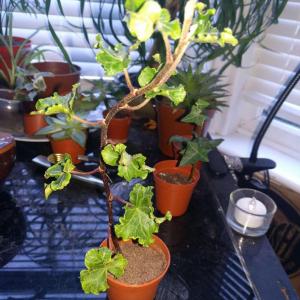
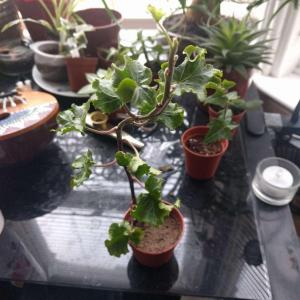


0
0
成长记
astronbot
2017年12月06日

I put these two in their own tiny pot since they fell off their mother leaf. I'm a little worried because their roots don't look very developed. I hope they do well on their own.
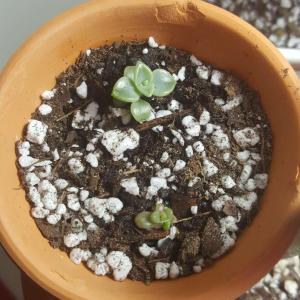

0
0
成长记
hege
2017年12月06日

this plant really went mad, this is what it looked like when I first got it, it grew a lot more stem between each leaf, then started loosing leaves at the bottom


0
0
meriunkat:@hege I see, you can also look into Grow Lights that emit about the same type of light that the sun provides
hege:I assumed it was due to something like that, I keep all my plants inside as I live in very cold england, I will make sure to keep this in a sunny window though
meriunkat:if your plant is kept inside, the succulent goes through etiolation Wich means the plant is not receiving enough sunlight there for it looks for it its self causing the stem to grow quicker and weaker with the leaves separated from each other



